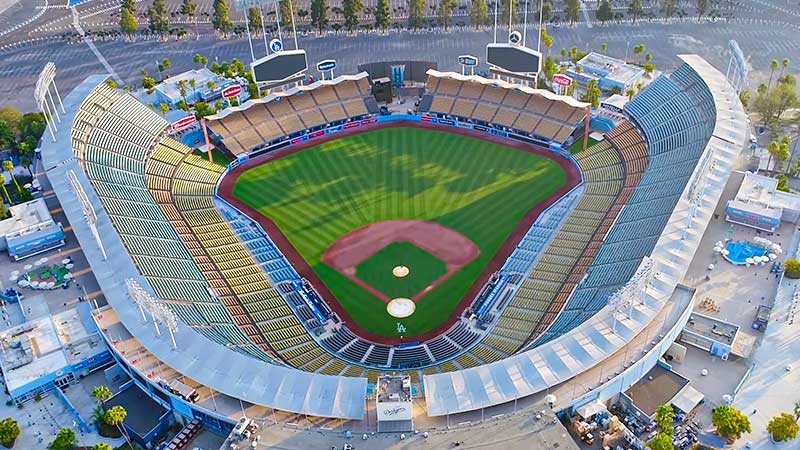Preserving the legacy of sports goes beyond the thrill of competition; it encompasses the historical and cultural significance of the venues themselves.
Baseball, known as America’s pastime, holds a special place in the hearts of fans across the nation. Within this realm, the oldest baseball stadiums stand as living testaments to the sport’s enduring heritage.
From the iconic Fenway Park, built in 1912, to the storied Wrigley Field, dating back to 1914, these hallowed grounds have witnessed legendary moments and become beloved landmarks.
As we explore the top 10 oldest baseball stadiums, we delve into the rich histories, unique features, and enduring charm that make these venues cherished and timeless symbols of our sporting culture.
Top 10 Oldest Baseball Stadiums
Here is the list of the top 20 oldest baseball stadiums. Please check the details.
1. Fenway Park – Boston Red Sox (1912)

- Address: 4 Yawkey Way, Boston, MA 02215, United States.
- Location: Fenway-Kenmore neighborhood of Boston, Massachusetts.
- Owner: Fenway Sports Group.
- Capacity: 37,755 (day games), 37,755 (night games).
- Record Attendance: The record attendance at Fenway Park is 47,627, set on September 22, 1935, during a doubleheader against the New York Yankees.
- Opened: April 20, 1912.
Overview: Fenway Park is the oldest Major League Baseball stadium still in use. It is known for its unique features, including the “Green Monster,” a high left-field wall that stands 37 feet 2 inches (11.33 meters) tall. Fenway Park has been the home of the Boston Red Sox since it opened in 1912.
The stadium has undergone several renovations and expansions over the years but has retained its classic charm. It is considered one of the most iconic and beloved sports venues in the United States and has hosted numerous historic baseball moments, including multiple World Series championships.
2. Wrigley Field – Chicago Cubs (1914)
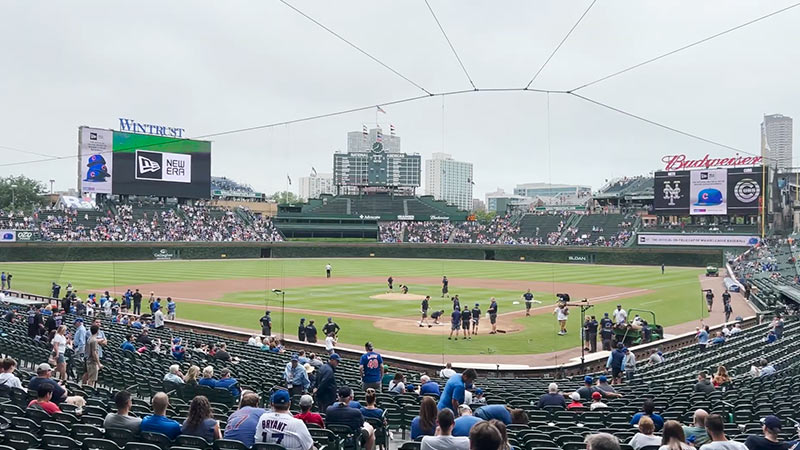
- Address: 1060 W Addison St, Chicago, IL 60613, United States.
- Location: Located in the Lakeview neighborhood of Chicago, Illinois.
- Owner: The Ricketts family (Chicago Cubs).
- Capacity: 41,649 (day games), 42,495 (night games).
- Record Attendance: The record attendance at Wrigley Field is 47,859, set on October 10, 1945, during Game 6 of the World Series between the Chicago Cubs and the Detroit Tigers.
- Opened: April 23, 1914.
Overview: Wrigley Field, often referred to as “The Friendly Confines,” is one of the oldest and most iconic baseball stadiums in the United States. It has been the home of the Chicago Cubs since it opened in 1914.
Wrigley Field is known for its distinctive features, including the ivy-covered outfield walls and the iconic red marquee at the entrance.
The stadium has undergone various renovations and expansions over the years while preserving its classic charm. It holds a special place in baseball history, hosting numerous historic moments and legendary players. Beyond baseball, Wrigley Field also hosts concerts and other events, making it a cherished venue for both sports and entertainment.
3. Dodger Stadium – Los Angeles Dodgers (1962)
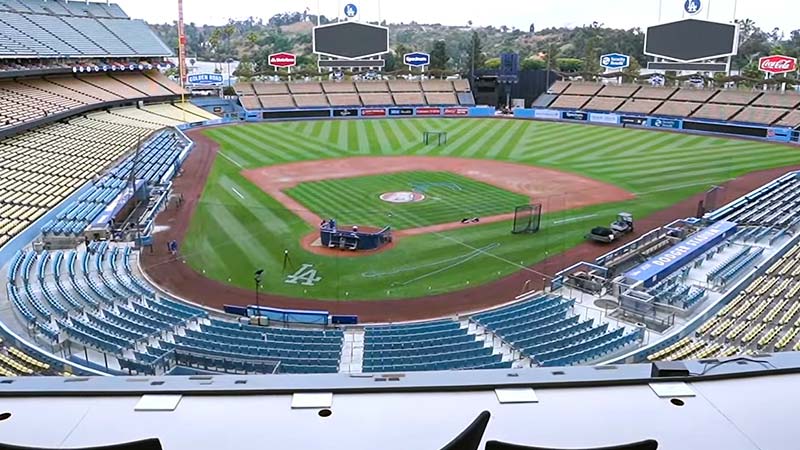
- Address: 1000 Vin Scully Ave, Los Angeles, CA 90012, United States.
- Location: Situated in the Elysian Park neighborhood of Los Angeles, California.
- Owner: Los Angeles Dodgers.
- Capacity: 56,000 (expandable to 56,000+ for special events)
- Record Attendance: The record attendance at Dodger Stadium is 57,099, set on March 29, 2008, during a game between the Los Angeles Dodgers and the Boston Red Sox as part of the Opening Series.
- Opened: April 10, 1962.
Overview: Dodger Stadium is a historic baseball stadium and the home of the Los Angeles Dodgers. It is renowned for its picturesque setting nestled in the hills of Chavez Ravine. Dodger Stadium has a distinct mid-century modern architectural design, with a sweeping roofline and a circular seating bowl.
It has undergone several renovations and upgrades over the years to enhance fan experiences and modernize the facilities. The stadium offers breathtaking views of downtown Los Angeles and the San Gabriel Mountains. Known for its pleasant weather and spacious seating,
Dodger Stadium provides a unique and enjoyable atmosphere for baseball fans. With a rich history and a loyal fanbase, it has hosted multiple World Series games and significant baseball events. Dodger Stadium is an iconic landmark in the city of Los Angeles and continues to be a beloved sports venue.
4. Oakland-Alameda County Coliseum – Oakland Athletics (1966)
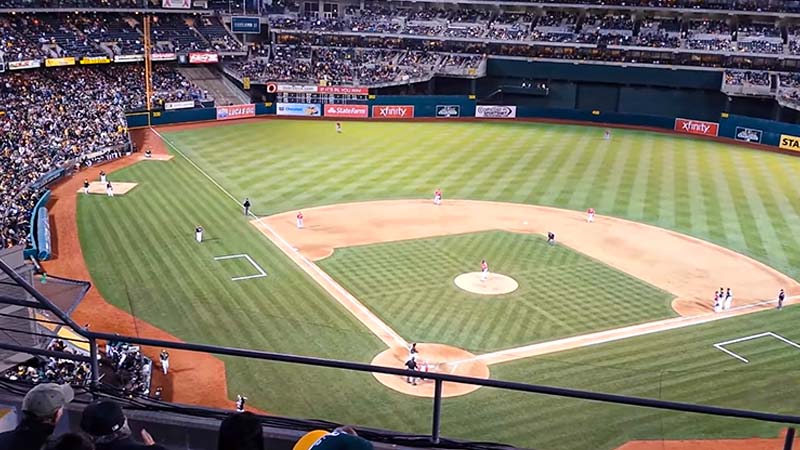
- Address: 7000 Coliseum Way, Oakland, CA 94621, United States.
- Location: Located in the Coliseum Complex in Oakland, California.
- Owner: Jointly owned by the City of Oakland and Alameda County.
- Capacity: 46,847 (baseball).
- Record Attendance: The record attendance at the Oakland-Alameda County Coliseum is 56,310, set on June 26, 2004, during a game between the Oakland Athletics and the San Francisco Giants.
- Opened: September 18, 1966.
Overview: The Oakland-Alameda County Coliseum, commonly referred to as the Coliseum, is a multi-purpose stadium and the home of the Oakland Athletics. It is one of the oldest stadiums in Major League Baseball.
The Coliseum has a dual-sport design, as it also serves as the home stadium for the National Football League’s Las Vegas Raiders. It has undergone various renovations over the years to accommodate both baseball and football events.
The stadium’s unique features include expansive seating, a large outfield foul territory, and the Mount Davis seating section, which was added for the return of the Raiders to Oakland.
While the Coliseum has a rich sports history and has hosted multiple World Series games, discussions have been ongoing regarding the construction of a new baseball-specific stadium for the Oakland Athletics. Despite its age, the Coliseum continues to be an important venue for baseball in the Oakland community.
5. Angel Stadium of Anaheim – Los Angeles Angels (1966)
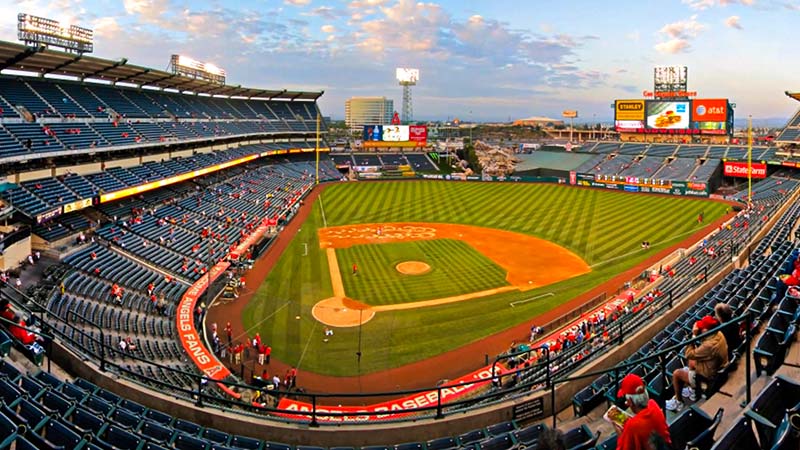
- Address: 2000 E Gene Autry Way, Anaheim, CA 92806, United States.
- Location: Situated in Anaheim, California.
- Owner: City of Anaheim.
- Capacity: 45,050 (baseball).
- Record Attendance: The record attendance at Angel Stadium of Anaheim is 64,407, set on July 20, 2008, during a game between the Los Angeles Angels and the Boston Red Sox.
- Opened: April 19, 1966.
Overview: Angel Stadium of Anaheim, originally known as Anaheim Stadium, is the home of the Los Angeles Angels. It is a prominent baseball stadium that has hosted numerous memorable games and events.
The stadium underwent significant renovations and improvements in the late 1990s and early 2000s to enhance the fan experience and modernize the facilities. Angel Stadium offers comfortable seating, ample concessions, and excellent sightlines for baseball enthusiasts.
The venue has also been a host for various non-baseball events, including concerts and other sporting events. Surrounding the stadium, fans can find a variety of amenities and attractions, such as the Angels Baseball Store and the Angels Hall of Fame.
Angel Stadium of Anaheim has played a vital role in the history of the Los Angeles Angels franchise and remains a beloved sports venue in Southern California.
6. Kauffman Stadium – Kansas City Royals (1973)
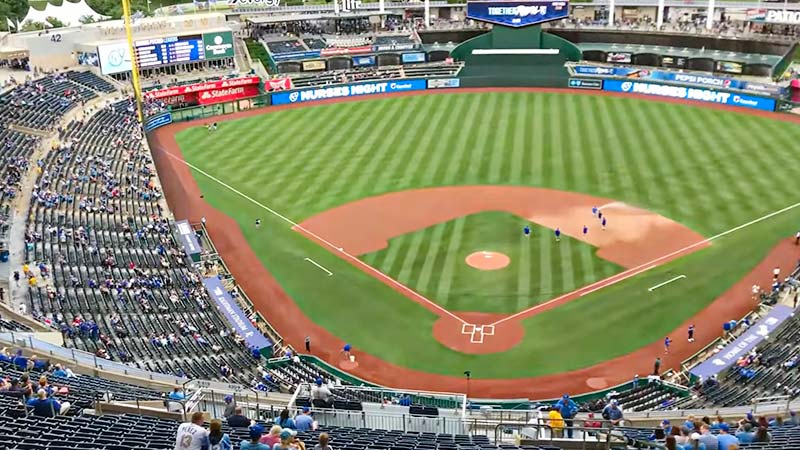
- Address: 1 Royal Way, Kansas City, MO 64129, United States.
- Location: Situated in the Truman Sports Complex in Kansas City, Missouri.
- Owner: Jackson County Sports Complex Authority.
- Capacity: 37,903 (expandable to 40,793 for special events).
- Record Attendance: The record attendance at Kauffman Stadium is 41,679, set on October 27, 2015, during Game 1 of the World Series between the Kansas City Royals and the New York Mets.
- Opened: April 10, 1973.
Overview: Kauffman Stadium, commonly known as “The K,” is the home of the Kansas City Royals. It is a modern and well-maintained baseball stadium with a unique design.
The stadium features a distinctive waterfall and fountain display beyond the outfield fence, known as the “Water Spectacular,” which adds to the aesthetic appeal of the venue.
Kauffman Stadium has undergone various renovations, including the addition of a high-definition scoreboard, upgraded seating areas, and improved amenities.
The stadium has witnessed several memorable moments in the Royals’ history, including World Series championships in 1985 and 2015.
With its comfortable seating, wide concourses, and family-friendlRoyals’y atmosphere, Kauffman Stadium provides an enjoyable experience for baseball fans. It serves as a symbol of pride for the Kansas City community and continues to be a cherished sports destination.
7. Rogers Centre – Toronto Blue Jays (1989)
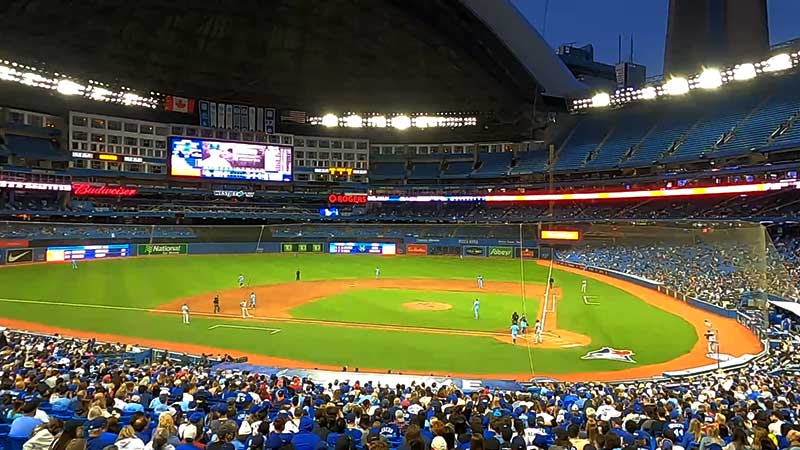
- Address: 1 Blue Jays Way, Toronto, ON M5V 1J1, Canada.
- Location: Located in downtown Toronto, Ontario, Canada.
- Owner: Rogers Communications.
- Capacity: 49,282 (baseball).
- Record Attendance: The record attendance at Rogers Centre is 52,682, set on October 23, 1992, during Game 6 of the World Series between the Toronto Blue Jays and the Atlanta Braves.
- Opened: June 3, 1989.
Overview: Rogers Centre, formerly known as SkyDome, is a multi-purpose stadium and the home of the Toronto Blue Jays. It is the first stadium in the world to have a fully retractable roof, allowing games to be played in various weather conditions.
The stadium’s unique design and features, including the ability to open or close the roof in approximately 20 minutes, make it a versatile venue for baseball games and other events.
Rogers Centre has witnessed significant moments in Blue Jays history, including their back-to-back World Series championships in 1992 and 1993.
The stadium has also hosted a wide range of non-baseball events, such as concerts, conventions, and even the National Football League’s Buffalo Bills games.
With its central location in Toronto’s entertainment district, Rogers Centre remains a prominent landmark in the city and a hub for sports and entertainment activities.
8. Tropicana Field – Tampa Bay Rays (1990)
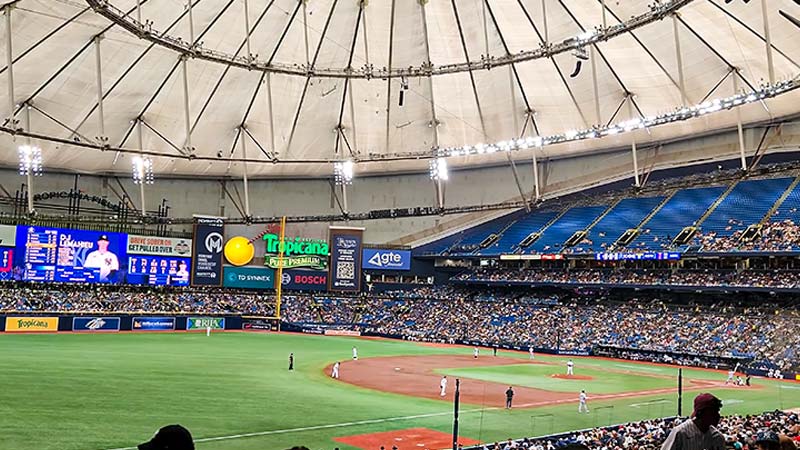
- Address: 1 Tropicana Dr, St. Petersburg, FL 33705, United States.
- Location: Situated in St. Petersburg, Florida.
- Owner: City of St. Petersburg
- Capacity: 25,000 (baseball).
- Record Attendance: The record attendance at Tropicana Field is 45,369, set on October 2, 1998, during Game 2 of the American League Division Series between the Tampa Bay Rays (then known as the Devil Rays) and the Chicago White Sox.
- Opened: March 3, 1990
Overview: Tropicana Field, often referred to as “The Trop,” is the home stadium of the Tampa Bay Rays. It is a domed stadium, providing a controlled environment for games regardless of weather conditions.
Tropicana Field features a unique design with its distinctive slanted roof and catwalks that can affect the trajectory of balls in play.
The stadium’s artificial turf surface further adds to its distinctive characteristics. While it has faced some criticism for its unusual sightlines and artificial playing surface, Tropicana Field has been the site of many memorable moments in Ray’s history, including their journey to the World Series in 2008.
The stadium offers a variety of amenities for fans, including food options, interactive exhibits, and a touch tank featuring live rays. Tropicana Field’s location in the St. Petersburg area provides a convenient venue for fans throughout the Tampa Bay region.
9. Guaranteed Rate Field – Chicago White Sox (1991)
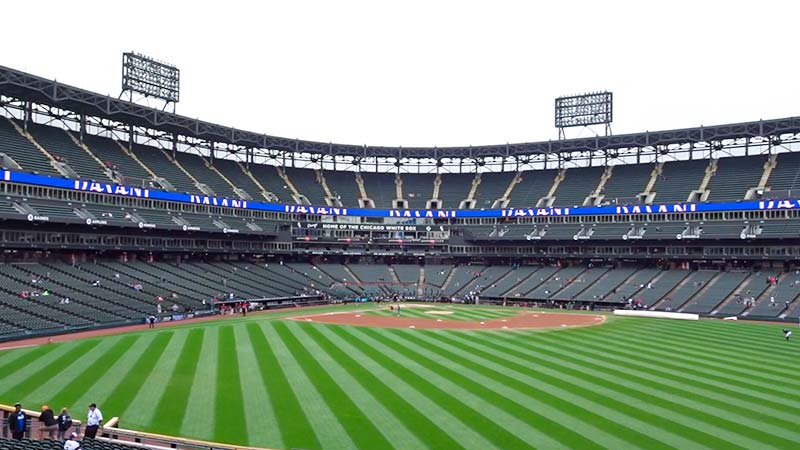
- Address: 333 W 35th St, Chicago, IL 60616, United States.
- Location: Situated in the Bridgeport neighborhood of Chicago, Illinois.
- Owner: Illinois Sports Facilities Authority.
- Capacity: 40,615 (baseball).
- Record Attendance: The record attendance at Guaranteed Rate Field is 47,754, set on April 22, 2006, during a game between the Chicago White Sox and the Cleveland Indians.
- Opened: April 18, 1991
Overview: Guaranteed Rate Field, formerly known as Comiskey Park, is the home of the Chicago White Sox. It is a modern baseball stadium with a design that emphasizes fan comfort and sightlines.
The stadium underwent significant renovations in 2003 to enhance fan experiences and improve amenities. Guaranteed Rate Field offers a variety of seating options, including luxury suites and club seating, providing a comfortable experience for fans.
The stadium features an open concourse design, allowing fans to enjoy views of the field while exploring various food and beverage options. Guaranteed Rate Field has been the site of many historic moments in White Sox history, including their World Series championship in 2005.
The stadium’s location in the heart of Chicago and its connection to the team’s rich history make it a beloved destination for White Sox fans.
10. Progressive Field – Cleveland Guardians (1994)
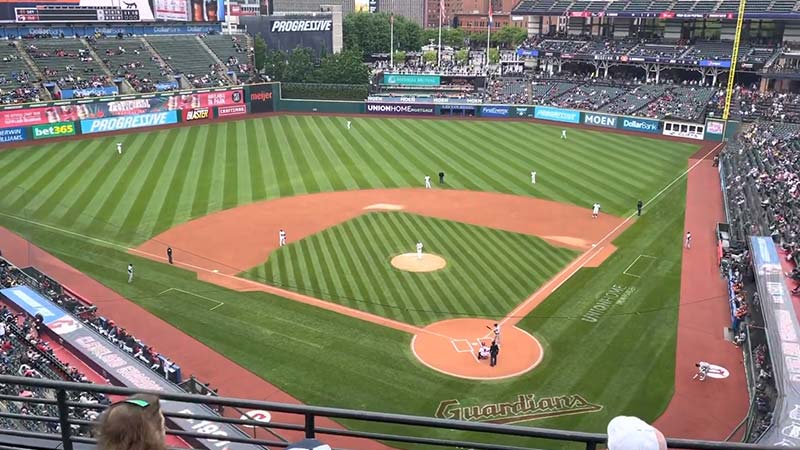
- Address: 2401 Ontario St, Cleveland, OH 44115, United States.
- Location: Situated in downtown Cleveland, Ohio.
- Owner: Gateway Economic Development Corporation of Greater Cleveland.
- Capacity: 34,788 (baseball)
- Record Attendance: The record attendance at Progressive Field is 46,870, set on October 26, 1997, during Game 7 of the World Series between the Cleveland Guardians (then known as the Cleveland Indians) and the Florida Marlins.
- Opened: April 2, 1994
Overview: Progressive Field, formerly known as Jacobs Field, is the home stadium of the Cleveland Guardians. It is a modern and fan-friendly baseball stadium known for its intimate atmosphere and architectural design.
Progressive Field features a blend of modern amenities and tributes to the team’s rich history, including the Heritage Park area, which showcases the team’s Hall of Fame plaques and other historical exhibits. The stadium offers a variety of seating options, including club seating, suites, and party decks.
Progressive Field has witnessed significant moments in Guardians’ history, including multiple trips to the postseason and exciting playoff games.
The stadium is situated in the heart of downtown Cleveland, allowing fans to enjoy the vibrant atmosphere and easy access to nearby restaurants and attractions. Progressive Field continues to be a beloved gathering place for Guardians fans and a symbol of pride for the Cleveland community.
Conclusion
The oldest baseball stadiums represent more than just venues for a game; they embody a sense of history, nostalgia, and community. These iconic landmarks have stood the test of time, witnessing generations of fans and countless memorable moments.
From the classic architecture of Fenway Park to the ivy-covered walls of Wrigley Field, these stadiums have become woven into the fabric of American sports culture.
Preserving and cherishing these historic venues is of paramount importance, as they continue to serve as gathering places for fans and as symbols of pride for their respective cities.
As we celebrate the enduring legacy of the oldest baseball stadiums, we recognize the profound impact they have on the spirit of the game and the collective memories they create for fans around the world. Thank you for your time.

